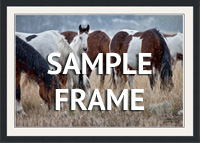3 Simple Tips when Photographing Wild Horses

3 Simple Tips when Photographing Wild Horses
3 Tips when Photographing Wild Horses
Without these simple tips, you may miss a perfect opportunity.
1. Have your camera ready at all times even before you arrive at your destination. Sometimes the horses can be found roaming in places you weren’t expecting. Seeing the horses early would be lucky since hunting them down can be the biggest challenge. A day or two before your arrival, try to research where the horses were last seen. Contact the BLM (Bureau of Land Management) or the organization that owns the land that the wild horses roam free on.
2. Horses like calm energy and if you are anxious to get the perfect photograph, the horses may feel threatened and will travel elsewhere. Try to be in the background, meaning be unnoticed to them and not in the middle of the herd. Unless there may be an exception when a friendly wild horse walks over to you and wants to be loved. My wife couldn’t resist the sweet lovin’ from the little Mustang.
There aren’t many horses like this, usually we need to keep our distance. In order to capture the perfect photograph, the horses should be comfortable in their surroundings. This means they aren’t bothered by your presence so they are comfortable to act as they normally would. You might catch the babies during nap time standing up or laying down. Remember that horses are wild animals. When you are near them move slowly, talk quietly, and keep your distance.
3. Consider the time of day you plan to photograph especially in the summer. If it is hot, the horses may be keeping cool by either resting in the shade or splashing in the nearest watering hole. This is an opportunity for some special photographs.
Seeing the horses close-up can create intimate wild horse photos by capturing the emotion on the horses’ faces. Some characteristics are easier to see than others. The ears are easy to read as they are like sensors. The ears are turned towards what they are thinking about except when they are pinned back, they are communicating that they are upset. If you are too close and the horse puts his ears back you need to move away quickly.
The muzzle can say a lot about the how the horse is feeling. If the muzzle is relaxed, then the horse is relaxed. If it is crunched up with wrinkles, the horse is not happy. The lips are the same, if the lips are droopy like they would blow in the wind, then he is relaxed. If his lips are firmly pressed, the horse is stressed. The eyes can also portray a mood. When a horse is happy and peaceful he will have relaxed soft eyes. When a horse is scared the whites of the eyes will show. A beautiful intimate horse photograph is to catch the light as it shines in the horses eye which creates a reflection in the pupil.
Don’t miss out on the sunrise and sunset hours when the wild horses will be feeling a little more energized from the cooler temperatures. This is when you can take some good action shots.
Have fun and enjoy!
To view nature photos of wild horses






